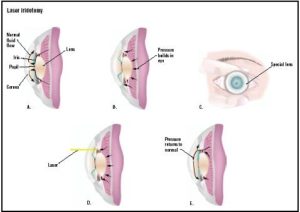
Normally intraocular fluid flows freely between the anterior and posterior sections of the eye (A). As pressure builds in the eye, this circulation is cut off (B). In laser iridotomy, a special lens is placed on the eye (C). A laser is used to create a hole in part of the iris (D), allowing fluid to flow more normally and intraocular pressure to return to normal (E). (Illustration by GGS Inc.)
Procedures: Laser Iridotomy
What is a laser iridotomy? Laser iridotomy is a laser procedure that makes a small opening in the iris (the colored part of the eye) to relieve increased eye pressure due to a type of glaucoma called angle-closure glaucoma.
When is it necessary? When the fluid that normally flows in and out of the eye cannot drain through its sponge-like drainage system, called the trabecular meshwork, pressure inside the eye (intraocular pressure) may rise. This rise in pressure could damage the optic nerve and lead to vision loss. The increased eye pressure may also push the iris forward, which blocks the drainage system completely, much like a stopper in a sink. This may trigger an angle-closure glaucoma attack, which is a medical emergency. A laser iridotomy is necessary when the fluid that drains from the eye is completely blocked. Laser iridotomy creates a new route for fluid to flow from behind the iris to the outflow drain of the eye. Laser iridotomy is also performed as a preventive treatment in eyes at risk for angle-closure glaucoma. How do I prevent an angle-closure glaucoma attack? An eye at risk for angle-closure glaucoma can be detected as part of a regular eye exam. Using a mirrored lens, your ophthalmologist can see if the trabecular meshwork is in danger of being blocked. A laser iridotomy may be recommended to prevent an angle-closure glaucoma attack. (Angle-Closure Glaucoma). Eye pressure builds up and pushes the iris forward, blocking the flow of fluid between the iris and lens. People of Asian or Eskimo ancestry have a higher risk of developing angle-closure glaucoma. Age and family history may also be risk factors, and women are at higher risk than men. What are the symptoms of angle-closure glaucoma? Not all people with angle-closure glaucoma experience an attack. When angle-closure glaucoma develops slowly, there are no obvious symptoms. However, your doctor may recognize your risk for angle-closure glaucoma before you experience any symptoms. Symptoms of an angle-closure glaucoma attack are:- Headache or eye pain
- Blurred vision
- Halos around lights
- Red eye
- Nausea and vomiting
If pressure is not relieved within a few hours, there may be permanent vision loss.
What can I expect if I have a laser iridotomy? A laser iridotomy is usually performed as an outpatient procedure. Your ophthalmologist will give you eyedrops to numb your eye and place a contact lens on your eye to precisely focus the laser. A laser iridotomy takes only a few minutes. You may see a bright light like a photographer’s flash. You may also feel a pinch-like sensation. In general, there are no activity restrictions following the laser treatment, although you should have someone drive you home after the procedure.Medications that can partially dilate the pupil, such as over-the-counter cold medications and antihistamines, should be avoided until after the laser procedure is performed. The opening made by an iridotomy is about the size of a pinhead. Typically, neither you nor your friends will notice it. It is usually located in the upper part of the iris, which is covered by your upper eyelid. Complications Loss of vision after laser iridotomy is rare. The main risks of the laser procedure are:
- The iris may be difficult to penetrate, requiring more than one treatment.
- A second procedure or another type of surgery may be required.
- A blood vessel in the iris may bleed.
- Medications may still be necessary.
Loss of vision can be prevented Laser iridotomy is a safe and effective procedure with few risks. While glaucoma treatments cannot restore vision already lost from glaucoma, early detection and treatment of glaucoma offers the best chance of preserving your vision.
